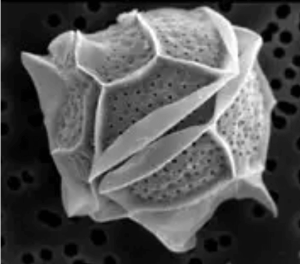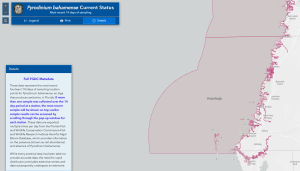
2025 reopen UPDATE (9-05-2025):
Pasco scallop season reopens for 2 weeks, starting September 6th, 2025.
FWC has reopened and extended the recreational scallop season in Pasco County. After continuous testing, measured levels for both the algae (Pyrodinium bahamense) and the toxin it produces (saxitoxin) have returned to safe levels based on the safety thresholds established by the National Shellfish Sanitation Program.
The season has been extended and opens September 6th through September 21st, 2025. Out of caution, it is recommended that you only consume the scallop muscle and not the roe or whole scallop.
Pasco County Scalloping Season Closure 2025 (8/6/2025)
The Florida Fish and Wildlife Conservation Commission (FWC) has announced a temporary closure of recreational bay scallop harvest in the Pasco County Zone starting on August 6th, 2025. This closure includes all state waters south of the Hernando-Pasco county line and north of the Anclote Key Lighthouse, including all waters of the Anclote River. This closure is related to the detection of the algae Pyrodinium bahamense and the toxin (Saxitoxin) they produce. The waters will be monitored continuously, and the scalloping season may be continued or extended once measured levels meet the safety thresholds established by the National Shellfish Sanitation Program. A similar bloom occurred in 2024 during the Pasco Scalloping season, causing a ~ month-long season closure, however, the season was later extended once toxin levels returned to safe levels.
Current status level for Pyrodinium bahamense can be found on the Florida Fish and Wildlife Conservation Commission website.
Pasco County Scalloping Season Closure 2024 (7/24/2024)
The Florida Fish and Wildlife Conservation Commission (FWC) has announced a temporary closure of recreational bay scallop harvest in the Pasco County Zone starting on July 24th, 2024. This closure includes all state waters south of the Hernando-Pasco county line and north of the Anclote Key Lighthouse, including all waters of the Anclote River. This closure is related to the detection of the algae Pyrodinium bahamense and the toxin (Saxitoxin) they produce. The waters will be monitored continuously, and the scalloping season may be continued or extended once measured levels meet the safety thresholds established by the National Shellfish Sanitation Program.
Current status level for Pyrodinium bahamense can be found on the Florida Fish and Wildlife Conservation Commission website.
2024 reopen UPDATE (8-27-2024):
Pasco scallop season reopens, starting August 28th, 2024.
Pasco scalloping

Pasco County serves as a popular destination for the recreational harvesting of the Florida Bay scallops, with lush seagrass beds and clear coastal water. Unfortunately, algae blooms in coastal Pasco County waters have resulted in high levels of neurotoxins affecting shellfish such as scallops, which have now impacted both the 2024 and 2025 harvest seasons.
As the southernmost county along Florida’s west coast, the open scallop season, occurring around July to August each year promotes local excitement and ecotourism. Scalloping provides a fun and educational activity, allowing snorkelers to interact with and learn more about the local environmental and food resources they can access.
Bay scallops are filter-feeding mollusks that thrive in shallow seagrass beds. These bivalves help improve water quality in the coastal Gulf waters by filtering out plankton, particles, and bacteria from the water column. In addition to aiding in our local water health, they also serve as a tasty treat! The inner muscle of a scallop has a tender texture and sweet flavor, which when cooked are enjoyed in a variety of dishes.
Toxins
Officials shut down the harvest zone for bay scallops in the middle of the 2024 and 2025 seasons, affecting Pasco scallopers. This shutdown was due to the high levels of saxitoxins and Pyrodinum bahamense, measured in the local waters. Pyrodinum bahamense is a type of marine plankton, called a dinoflagellate, which can occur as large algae blooms in coastal waters. These large algae blooms produce high levels of saxitoxins, a Paralytic Shellfish Toxin, which impacts shellfish such as scallops.

As the scallop filter feeds on the marine plankton, the saxitoxins accumulate in their bodies. The scallops ability to concentrate the toxin to high levels, results in its health risk to humans. Contaminated shellfish can cause sickness and life-threatening symptoms due to Paralytic Shellfish Poisoning. Cooking the scallops will not destroy these toxins, as they are heat-stable. The toxins do not have a flavor or smell, so there is no way to know if the toxin is present in the shellfish. When the toxins are measured in the local waters it is best to avoid eating shellfish for several weeks after the algae bloom occurs.
Why did the bloom happen?
During its life cycle, the Pyrodinium bahamense marine plankton produces a seed-like cyst that settles into the coastal sediments. The cyst remains on the sea floor until local conditions become favorable for cyst germination, resulting in an algae bloom. The concentration of these cysts and the local conditions can impact the intensity of the bloom.

These blooms are typically naturally occurring, however, more studies are focusing on potential environmental triggers. Heavy rainfall, nutrient variation, and temperature changes in the water have been suggested to influence the timing and intensity of these blooms.
The levels of saxitoxins and Pyrodinum bahamense in the waters of Pasco County are being continuously monitored by the Florida Fish and Wildlife Conservation Commission (FWC). Toxins levels must drop below the safety threshold, established by the National Shellfish Sanitation Program, before the FWC will reopen harvesting in the detected areas. As toxins can remain in the tissue of the shellfish for several weeks, caution should be taken when harvesting after a bloom.
Current status level for Pyrodinium bahamense can be found on the Florida Fish and Wildlife Conservation Commission website.

Where can I scallop?

Scallopers are encouraged to travel to other counties, such as Hernando and Citrus, to continue to harvest scallops, as no saxitoxins have been measured in those regions. You may travel by boat to other counties to harvest scallops, however, make sure you are not stopping in the closed counties with your harvest. Instead, travel directly through!
For information related to scalloping in the other counties visits the FWC website!
Is the water safe to swim?
Luckily, Pyrodinium bahamense and its associated toxins do not directly impact human health, thus swimming in the water impacted by these saxitoxins is safe. The danger comes from eating organisms, like shellfish or puffer fish, which have high concentrations of the toxins. Other, harmful algae blooms, like red tide, however, can cause health impacts for humans. More information on these other HABS can be found on the Florida Sea Grant page.
2024 reopen UPDATE (8-27-2024):

Pasco scallop season reopens, starting August 28th, 2024.
FWC has reopened and extended the recreational scallop season in Pasco County. After continuous testing, measured levels for both the algae (Pyrodinium bahamense) and the toxin it produces (saxitoxin) have returned to safe levels based on the safety thresholds established by the National Shellfish Sanitation Program.
The season opens August 28th and is extended through September 24th, 2024. Out of caution, it is recommended that you only consume the scallop muscle and not the roe or whole scallop.
More information:
Bay Scallop Blog: https://blogs.ifas.ufl.edu/pascoco/2025/07/07/gulf-catchandcook-july-bayscallop/
Map of current status level for Pyrodinium bahamense: https://gis.myfwc.com/PyrodiniumMap/
References:
Karlen, D. J., & Campbell, K. (2012). The distribution of Pyrodinium bahamense cysts in Old Tampa Bay sediments. Environ. Prot. Comm. Hillsoborough Cty.

Have a question? Ask the Author!
For more detailed information, contact your local University of Florida Extension Office.
Follow us!
An Equal Opportunity Institution.
 7
7
